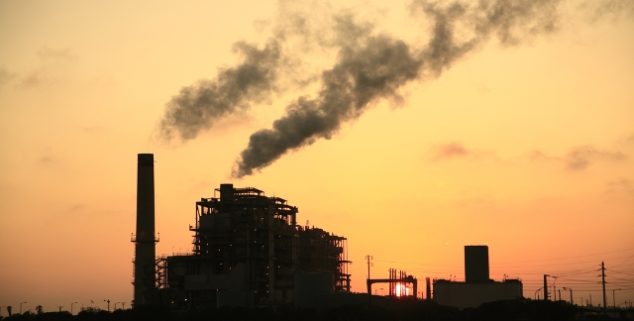News
Cap-and-trade deal heading for showdown
 A California power plant at dusk. (Photo David Crockett)
A California power plant at dusk. (Photo David Crockett)A hotly disputed agreement to extend California’s cap-and-trade program to 2030 partly reflects the power shift under way in the Legislature in which moderate, business-friendly Democrats are increasingly flexing their political muscle.
It also shows the lobbying clout of the petroleum industry and divisions within the environmental community.
The negotiated compromise between lawmakers and Gov. Brown’s administration continues California’s cap-and-trade effort a decade past the 2020 expiration date.
Together, those factors have spurred legislation that effectively thwarts a measure that environmental justice advocates successfully sought last year. And it puts before the Senate and Assembly legislation that was blocked just weeks ago in a different form.
Floor votes, which had been scheduled for Thursday, were delayed until Monday, July 17, in both houses. The governor, who announced the agreement earlier this week, and leaders of both houses support the proposal.
“There has been a set of folks pushing very hard,” said Amy Vanderwarker of the California Environmental Justice Alliance, displaying the “lobbying power of the moderate Democratic caucus.”
“It was definitely a full-court press by big oil … It reduces climate revenues that have been going to environmental justice. We feel as a coalition that big oil is dictating climate policy now,” she added.
The negotiated compromise between lawmakers, environmentalists, business interests, oil companies and Gov. Brown’s administration continues California’s cap-and-trade effort a decade past the 2020 expiration date. That is a goal sought by Brown, who uses California as an example to the international community of an effective program curbing climate-changing greenhouse gases.
The California system — known as a “market-based mechanism” as opposed to top-down government regulations — includes auctions for companies to buy, sell and trade credits that allow them to continue operating while they gradually cut back on their greenhouse gas emissions to below 1990 levels.
The program has produced about $3.4 billion in proceeds to the state distributed by the Legislature, according to the Air Resources Board, which administers the auctions.
The proposed extension, a two-bill package, changes the existing system.
“This a direct attack on proposed refinery emission reductions measures by 20 percent.” — Diane Takvorian
It calls for large numbers of free credits to be distributed through the decade, which critics contend imperils the ability of the state to meet its 2030 emission goals, 40 percent below 1990 levels, according to Diane Takvorian of the Environmental Health Coalition, a member of the Air Resources Board.
The administration disputed her characterization of the program, and said the free allowances actually are reduced 40 percent under the latest legislation, which ensures that California will meet its greenhouse gas reduction goals.
It eliminates a roughly $120-$150 “fire prevention fee” on many rural properties, a controversial fee that has been used for fire education and prevention, but not for fire suppression. It authorizes state regulators to place price caps on credits to help businesses meet the costs, and it also exempts electric utilities from sales and use taxes on equipment purchases.
It also bars local air districts from regulating some emissions of entities outside the market-based system, and cuts back on the locals’ authority to regulate carbon dioxide emissions. “This a direct attack on proposed refinery emission reductions measures by 20 percent. Refineries,” Takvorian added, “are one of the largest sources of greenhouse gases.”
Vanderwarker said successful efforts to expand the ARB board’s membership earlier legislation — AB 197 of 2016 — to provide representation for communities hit especially hard by pollution would be unraveled.
But other environmentalists said that, overall, the package was a good one.
They noted that it contains provisions for updating antiquated equipment and limits the companies’ ability to pay for so-called “offsets” — tree groves for example — to within California’s boundaries. There are provisions in the accompanying bill to target air pollution in areas in neighborhoods with dirty air.
“The concessions to industry are bitter pills, but on balance the package ensures our emissions limits are enforceable against polluters and secures critical gains to improve air quality for millions of Californians,” said Alex Jackson, the legal director of the Natural Resources Defense Council’s California climate project.
“The world is watching for California to chart a path through the climate denial and obstruction coming from the White House – and California is yet again poised to deliver,” he added in a written statement.
To emerge from the Legislature, the package will need two-thirds votes in both houses – a threshold demanded by Brown to protect the program against legal challenges.
—
Ed’s Note: Corrects language in 13th graf to show show annual fire fee used for prevention and education, not fire suppression.
Want to see more stories like this? Sign up for The Roundup, the free daily newsletter about California politics from the editors of Capitol Weekly. Stay up to date on the news you need to know.
Sign up below, then look for a confirmation email in your inbox.

Self Driving Transportation and Renewable Fuel are interesting Conversation
Fed EPA-Trump May Prove interesting to Watch
AB 1274 O’Donnell App’s Scheduled For Monday?